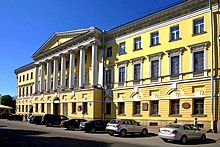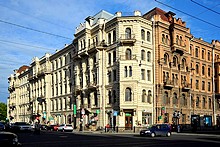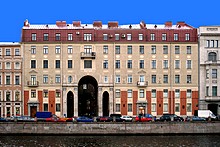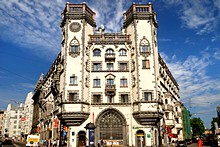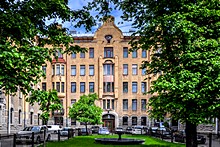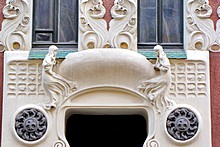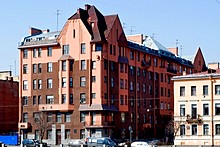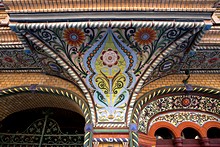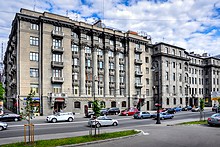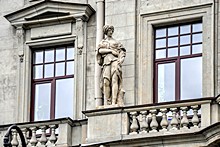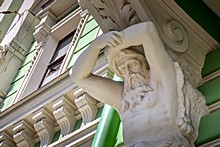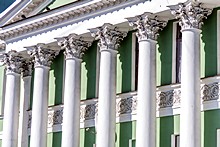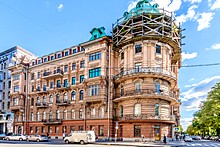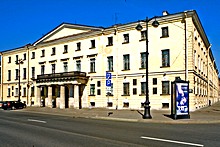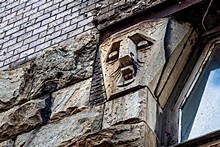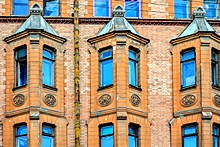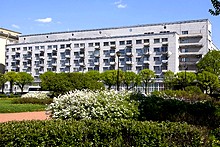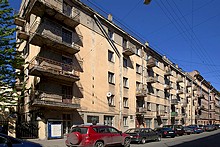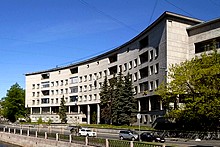Apartment Buildings
Famed for its palaces and museums and thoroughly imbued with an air of past glories, St. Petersburg is, in broad historical terms, a very modern city. Its development coincided with the general European trend for urbanization and the adoption of the apartment as the main style of accommodation for city dwellers. By the mid-19th century, only a tiny percentage of the population at the very top of the social ladder could afford to live in private houses, and the vast majority of Petersburgers were moving to rented accommodation in apartment buildings.
The "dokhodny dom" (tenement building) was not only the easiest way to accommodate the city's rapidly growing population, it was also an attractive investment for St. Petersburg's wealthy merchants and industrialists, and even for many members of the aristocracy. Apartment buildings, usually of four or five stories and with a small inner courtyard, began to spring up throughout the historic centre, bearing the names of the prominent citizens who had commissioned them.
The owners would often have their commercial premises and their own apartments on the lower floors of the building, with the second floor traditionally occupied by the most luxurious living quarters, and apartments decreasing in size and splendor the higher the floor.
As for many owners the apartment building would be their own home as well as a business project, they were generally willing to spend lavishly on decoration and design. There are numerous masterpieces of eclectic, revival, Art Nouveau and Russian Neo-classical architecture among the St. Petersburg apartment buildings of the late-19th and early 20th centuries. Sources of architects' inspiration ranged from classical temples to Venetian palaces and medieval castles, and in some cases the elaborate decorations became synonymous with the buildings themselves, so that names like "the house with towers" or "the house with owls" have an almost official status in local nomenclature.
The grand era of apartment houses in St. Petersburg came to an abrupt end with the October Revolution. With the honorable exception of a few ground-breaking constructivist housing projects of the late 1920s and a handful of neighborhoods that benefited from the Stalinist construction boom of the 1950s, the main Soviet solutions to the housing problem were to first slice up the palaces, mansions and grand lodgings of the pre-Revolutionary elite into cramped communal apartments, and later to throw up the endless rows of monotonous prefabricated blocks that comprise most of St. Petersburg's dormitory regions.
Nonetheless, it is the comparative lack of 20th century construction projects that has allowed St. Petersburg to retain the historic aspect of the city centre like a museum of the pre-Revolutionary era, a fact recognized by UNESCO's decision to designate the whole area a world heritage site in 1990. While many of St. Petersburg's historic buildings have been shockingly abused and neglected over the last century, the sense of living amongst the decaying grandeur of a past civilization has an insidious charm that seduces locals and visitors alike. In this respect, St. Petersburg truly is the "Venice of the North", and nowhere is the juxtaposition of modern living and the social order and design of the past more tangibly experienced than in the city's grand historic apartment buildings.
A magnificent neoclassical apartment building from the early 19th century next to the Field of Mars, the Adamini House enjoyed multiple connections with St. Petersburg's pre-Revolutionary cultural elite.
This five-story building at the corner of Liteiny Prospekt and Ulitsa Pestelya is a magnificent example of Moorish style and became a landmark on both the topographical and the literary maps of St. Petersburg.
This Northern Moderne building located on the Fontanka River is well known for its spectacular architectural design around two broad courtyards, and the large number of prominent people who have lived here at different times.
The two tall hexagonal towers attached to this impressive house on Ploshchad Lva Tolstogo (Leo Tolstoy Square) mix Gothic and Renaissance motifs to stunning effect.
The house of the architect Fyodor Lidval on Kamenoostrovsky Prospekt is a striking representation of the Northern Moderne style, with four asymmetrical wings showing Lidval's development of the style.
Although somewhat out of the way, this extraordinary Art Nouveau building is one of the most famous in St. Petersburg thanks to the magnificent ceramic mosaics that cover a whole floor of the facades.
A striking asymmetrical building next to the Fontanka River, the Kapustin Apartment Building is over a century old, but its extremely simplified version of Style Moderne now seems remarkably contemporary.
One of the few Russian Revival secular buildings in St. Petersburg, the riotously decorated apartment house of architect Nikolay Nikonov is a fairytale creation and among the most original buildings in the city.
These three grand apartment houses in a row on Kamennoostrovsky Prospekt pioneered the Russian Neoclassical Revival, combining modern techniques and proportions with classical forms.
This large complex of buildings on Kamennoostrovsky Prospekt represented the height of bourgeois luxury in the pre-Revolutionary era, and was home to several celebrated citizens of St. Petersburg.
This monumental eclectic style building is characterized by its high arch and richly decorated four-story facade. It was built by Pavel Suzor, one of the best and most prolific Petersburg architects.
This small, remarkable building from the 18th century is famous around Petersburg for its rotunda which connects more than one generation of citizens with its mystical secrets and powerful energy.
This Art Nouveau house next to the Tauride Garden, famous for its striking tower, was a nexus for the cream of St. Petersburg's Silver Age writers, visiting the prominent poet and critic Vyacheslav Ivanov.
This building has little remarkable architecture but has a rich history. At various times more than fifty well-known Russian scientists have lived here, the most famous being Nobel prize-winning physiologist Ivan Pavlov.
This house in the city center is a magnificent monument to Northern Moderne, the folk-inspired style that connects St. Petersburg with its closest northern neighbours.
Viktor Schroeter, pioneer of the "brick style" in the late 19th century, used his home and the neigbouring apartment building to introduce St. Petersburg to his revolutionary techniques.
A seminal building with a tragic history, this constructivist landmark on Troitskaya Ploshchad (Trinity Square) has been almost as badly abused as the Tsarist-era dissidents for whom it was built.
This centrally located constructivist building was designed as a commune for engineers and writers, the "builders of Socialism". It offered a new model of living to young Soviet citizens with very mixed results.
Built for Leningrad's Party elite, this attractive riverside complex was one of the last constructivist buildings to be erected in the city, combining very modern forms with a high level of luxury inside.

